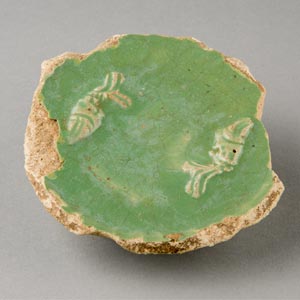Bowl with Double Fish Motif
The Show

Celadon glaze stoneware bowl with molded double fish motif 14th century, Longquan kilns, Zhejiang Province, China Glazed ceramic University of Michigan Museum of Anthropological Archaeology, 35226
This ceramic vessel's pale green glaze is typical of Chinese celadon wares. While lotus petals decorate the dish's exterior, a molded design forms two small scaly fish on its interior. The double fish motif is a traditional Chinese symbol of marital happiness as the word for fish (yu) is a homophone for wealth and abundance. The fish would have appeared to come to life when the bowl was filled with undulating liquid. These and other Chinese ceramics were imported into the Islamic world, where they inspired Muslim artisans to imitate and experiment with Chinese designs and colors. Most frequently, the Islamic versions of these imported wares emphasized the aesthetic look of the imported product over fidelity to its material makeup and manufacturing technique.
Bibliography: Grube 1976, 278–281; Gompertz 1958, 104–105; Baer 1968; Crowe 1975–1977, 264–272; 1976; Gyllensvard 1973; and Scanlon 1984, 116–117; 1970b, 88.
Return to the Show



